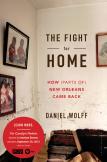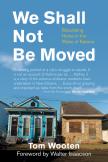The Big Easy's Comeback
Those of us who endured the rebuilding process after Hurricane Katrina cannot help but empathize with Northeasterners reeling from Sandy. We know what it is like to see our world upended, we know the disruptions that lie ahead, and we wouldn’t wish such a fate on the devil himself. Please pardon us, then, if some of us feel the tiniest twinge of satisfaction that the world has been reminded that not even the nerve center of America’s power elite is immune from confronting the issues Katrina briefly placed before the public.
New Orleanians are deeply sensitive about the ambivalence the rest of the country sometimes shows us. We pounce with unseemly zeal on outsiders who casually refer to Katrina as a “natural disaster.” Them’s fighting words in the Crescent City, and the utterance of this cliché in any Katrina-related conversation invariably presages a long harangue about the engineering flaws in the metro area’s federally-constructed levees that we had been told for decades were adequate to the task of defending the city against Katrina-like storm surges. But what galls us most is the lingering notion that our city must justify its continued existence. In an era in which the zeitgeist demands that everything must pay for itself, many Americans seem wary of public investment in disaster prevention and recovery.
Two recent additions to the Katrina bookshelf by Tom Wooten and Daniel Wolff focus primarily on the complexities confronted by ordinary individuals rebuilding their homes and entire neighborhoods in the fog of confusion that surrounded local civic life in the years immediately following the flood. Both authors frame their narratives around the struggles, setbacks and triumphs of several locals who are more or less representative of the city’s working and middle classes. Many of these people had little or no experience in community organizing or neighborhood planning. They stepped forward during a period when New Orleans seemed rudderless, its municipal government sending mixed signals about the direction recovery would take.
The city’s vaguely Old World social fabric has always meant that for all its neighborhood pride and family cohesion, neither grassroots organizing nor progressive-style central planning has ever quite taken root. Consequently, local authorities flailed about for months after the storm, initiating a series of poorly conceived planning efforts, each of which met with public disdain or confusion before being dropped.
The most notorious of these was the first one: the Bring New Orleans Back plan, devised by a blue-chip commission of local grandees. Barely five months after Katrina, this panel’s report landed on the front page of the newspaper with large green dots superimposed over a map of the city in neighborhoods the plan suggested would have to prove their viability before building permits would be issued.
To this day, mere mention of the Big Green Dots is enough to drive many New Orleanians into fits of apoplexy. The administration of then-mayor Ray Nagin almost immediately backed away from the proposal, any possible merits of which were made moot by the simple political reality that the public would not countenance the abandonment of any neighborhood. Both Wooten and Wolff strongly convey to the reader the intense fear and mistrust felt by large swaths of the populace during these months. Over and over we read of locals haunted by the conviction that bulldozers would soon arrive to scrape clean their entire neighborhood and snatch away what remained of their world. (Both authors do well in pointing out the surprisingly high rate of home ownership in even the notoriously impoverished Lower Ninth Ward.)
“Developers,” a concept invoked as a power of almost mystical proportions, quickly became the bête noire of thousands of traumatized citizens convinced that their little patch of the world would soon be socially engineered out of existence to the benefit of land speculators. It is a testimony to the chasm that exists between social classes, to say nothing of the legacy of racism, that these fears acquired such currency so quickly.
As local authorities appeared to botch the planning process and the state’s primary mechanism of relief, the Road Home program, proved itself a bureaucratic nightmare, it was left to newly minted neighborhood activists to step into the breach. In We Shall Not Be Moved, Tom Wooten introduces the reader to a half-dozen or so private citizens who spearheaded new neighborhood associations, created resource centers to assist homeowners, revitalized church ministries and led the community planning process from the bottom up at a time when no other entity appeared capable or trusted enough to do so. Their collective efforts would be instrumental in the professional drafting of a unified master plan ratified by voters and the city council several years later.
Wooten ably conveys his admiration for his subjects, yet one sometimes wishes his protagonists seemed more vivid. The book too often lacks texture in its portraits of these leaders, and their struggles start to blend together rather too much. Daniel Wolff is more successful in this respect, and The Fight for Home is generally a more engaging read, although the author displays a penchant for quoting his subjects—including a black pastor, a group of quasi-anarchist volunteers and two ordinary working-class families—at perhaps too great length. But in their unfiltered comments and monologues, we see once and again both a deep mistrust toward developers and frustration at being hung out to dry by the authorities.
Wolff works on a somewhat broader canvas than Wooten, and the reader gains a sense of both the social pathologies of New Orleans (a pastor describes his city as a “happy plantation,” whose residents fatalistically accepted its anemic service economy in exchange for a low cost of living) and the bungling of the authorities, who deliver FEMA trailers contaminated with formaldehyde, slash the number of public housing units, and award the usual sweetheart contracts for debris removal and the like.
He devotes much space to the considerable efforts of Common Ground, a collective that described itself as providing “service-oriented direct action” to residents trying to rebuild. A relative novelty in a city lacking any such tradition, Common Ground was founded by an ex-Black Panther native of the city, and it was sustained for several years by thousands of mostly young, white volunteers from across the country. Perhaps because of its self-styled radical politics, the group was rarely taken seriously by the local media, and the extent of its efforts (tool libraries, a free health clinic, etc.) may come as news even to many New Orleanians.
Both Wooten and Wolff present an ultimately cheerful view of the city’s progress since Katrina, and they are right to celebrate the determination and resourcefulness of their protagonists. Still, it may give readers pause to consider the extent to which individual citizens must take charge of their own recovery from catastrophes like Katrina, with many of the most isolated and vulnerable people at a considerable disadvantage. Is it not possible that a nation that chose to spend vast amounts of its treasure on the sort of military adventures supported by politicians and voters of both parties in states like Louisiana might find a way to fund stronger levees and other infrastructure to protect its people from the perils of a changing climate?
Wouldn’t the revenue saved allow us to devise more generous and efficient mechanisms for providing disaster relief? Might not the security generated by these efforts promote a greater sense of social cohesion that would dispel fears of dark plots by real estate developers and other bogeymen?
Sadly, our society seems no closer to addressing these questions today. Wolff observes that Louisiana led the way in America’s addiction to cheap energy, and indeed the state’s decision to prostrate itself to the oil industry, which has done little to enrich its people and much to scour away the wetlands that once protected the state’s major population centers from hurricanes. Sandy notwithstanding, it may be the Gulf South that provides the leading indicators for a future of weaker government, more frequent and severe weather disasters and an atomized population that relies on its own pluck and wit to survive.
This article also appeared in print, under the headline “The Big Easy's Comeback,” in the February 25, 2013, issue.









